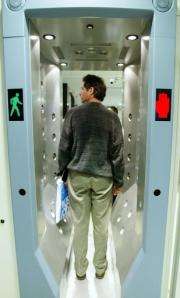After foiled US plane attack, scanners revisited

As US lawmakers demand to know how a would-be attacker smuggled explosives aboard a plane on Christmas Day, the use of body scanners at airport security points is likely to be revisited.
The machines are considered effective and have been tested at numerous international airports, but they are also controversial because they scan beneath clothing to detect items that may be hidden from ordinary view.
But security experts believe that the scanners could have detected the explosives that Umar Farouk Abdulmutallab was hiding as he boarded a Northwest Airlines plane in Amsterdam last week.
Abdulmutallab attempted to bring down the Airbus 330 by combining a flammable liquid he was carrying in a syringe with an explosive powder known as pentaerythritol or PETN that was sewn into his underwear.
The metal detectors that passengers ordinarily step through as their luggage is being x-rayed would not have detected either component, experts said.
In the wake of the failed attack, British Interior Minister Alan Johnson said Monday he would consider installing full body scanners at British airports "as quickly as possible."
In the United States, the scanners are already used at 19 airports and a handful of courthouses and prisons, according to the Transportation Security Administration.
The machines look like small booths and use radio frequencies to scan underneath clothing and produce a 3D image of the individual's body. Related article: Obama syays 'will not rest' until air terror plotters caught
While the scanner does not produce an image of the naked body, it has caused consternation among privacy advocates because it does faithfully reproduce individual curves hidden beneath clothing, from the shape of a breast to a roll of fat.
The device has been tested in numerous European airports but its use was halted after the European Union expressed concerns and protested a plan to install the scanners at airports throughout the EU.
EU representative Martine Roure praised the mothballing of the project, saying it would have been "disproportionate to submit all passengers to this type of check in the name of the fight against terrorism."
But Thursday's attack, which was prevented by passengers and crew who overwhelmed Abdulmutallab, could prompt lawmakers worldwide to change their minds about the body scanners. Related article: Airports step up security after failed attack
Successful and failed terror attacks targeting airplanes have already led to significant changes to the way people fly.
After the September 11, 2001 attacks, pilots began locking the cockpit door behind them to prevent hijackers from accessing the flight controls.
In the wake of Richard Reid's failed December 2001 attempt to detonate explosives in his shoes, passengers now routinely submit their footwear to inspection before boarding a plane.
And after authorities uncovered a plot in 2006 to blow up airliners with explosives in liquid containers, new regulations were imposed limiting the amount of fluid each traveller could bring aboard a flight.
Bruce Hoffman, a terrorism expert at Georgetown University, told AFP that traditional security measures simply would not be able to detect the sort of explosive Abdulmutallab was carrying.
"There is no other way, except for a body scan, to detect it," he said.
Even the secondary screening measures sometimes used at airports would have failed, he added.
"If it (the explosive PETN) was sealed extremely tight in plastic, dogs wouldn't have picked it up."
Douglas Laird, a former security director for Northwest Airlines, agreed, noting it was virtually impossible to know what was concealed beneath clothing without the scanners.
But some are more skeptical about the efficacy of the machines, including Jimmie Carol Oxley, the co-director of the Center of Excellence in Explosive Detection, Mitigation, Response and Characterization at the University of Rhode Island.
"Anything is hard to detect if you're not looking for it," he pointed out, noting that airport security already has machines that can detect PETN.
"If you go through the airport and they ever pull you over for your carry-on and they swab your carry-on, they can pick up that, those machines detect it."
The machines also come with another problem: they cost around a million dollars, 20 times more than a standard X-ray machines, according to Laird.
(c) 2009 AFP


















